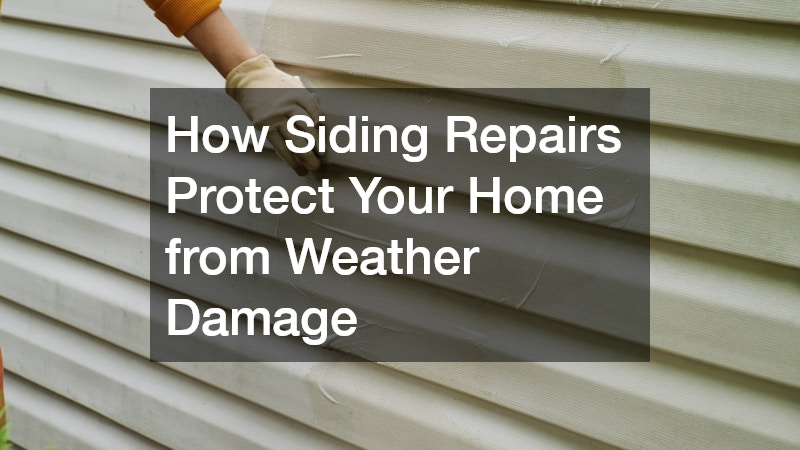Siding serves as the first line of defense against the elements, making it essential for homeowners to ensure that their siding is in good condition. Weather damage can lead to costly repairs if not addressed promptly, impacting the overall integrity of the home. Therefore, understanding the importance of timely siding repairs is crucial for maintaining a safe and comfortable living environment.
When siding is compromised due to wear and tear or adverse weather, it can pave the way for issues such as mold, rot, and pest infestations. These problems not only affect the structural soundness of the home but can also diminish its aesthetic appeal.
Therefore, homeowners should regularly inspect their siding and be aware of repair options available to them.
What are the Signs That My Siding Needs Repair?
One of the first signs that your siding needs attention is the presence of cracks, holes, or warping. These imperfections can compromise the siding’s ability to protect your home from moisture and wind. Homeowners should routinely examine their siding for these visual indicators and address them immediately to prevent further damage.
Another sign that your siding may need repair is the appearance of peeling or bubbling paint. This often indicates moisture trapped beneath the surface, which can lead to wood rot and ultimately expose your home to further weather-related issues. Keeping an eye on the paint’s condition can help you catch problems early.
In addition to physical signs, homeowners should also be alert to changes in their utility bills. Increased energy costs may signal that damaged siding is affecting the home’s insulation. If you notice such changes, it may be time to assess the condition of your siding and consider necessary repairs.
How Do Siding Repairs Contribute to Energy Efficiency?
Properly maintained siding can serve as an effective barrier against heat and cold, which is essential for energy conservation. Insulated siding, for instance, can significantly reduce heating and cooling costs by keeping the desired temperature in and preventing outside weather fluctuations from impacting the home’s interior. This can lead to long-term savings for homeowners.
When insulation materials are compromised due to damaged siding, it can result in poor energy performance. Cracks and gaps allow outside air to infiltrate the home, forcing heating and cooling systems to work harder. Timely siding repairs can seal these openings, improving the home’s overall energy efficiency significantly.
Ultimately, investing in repairs not only preserves the home’s physical structure but also leads to cost-effective energy management. Functional siding minimizes reliance on HVAC systems, enabling a more sustainable lifestyle while contributing to eco-friendly habits. Homeowners should prioritize siding maintenance as a practical step toward energy efficiency.
What Types of Weather Damage Can Siding Repairs Address?
Weather can wreak havoc on siding materials, leading to issues such as water infiltration and mold growth. When siding is left unaddressed, these problems can escalate, causing extensive damage to wall structures. Timely repairs can prevent these weather-related concerns, protecting the home’s envelope and promoting a healthier living environment.
Wind damage is another serious issue that siding can face, especially in regions prone to storms. Loose or missing siding can allow wind and rain to penetrate and damage underlying structures. Repairing siding before a storm hits can safeguard your home from significant weather-related destruction.
Furthermore, UV rays can cause fading and degradation of siding materials, leading to a weakened surface area. Repairs that include repainting or sealing can extend the life of your siding and keep your home protected. By addressing these problems, homeowners can maintain their property’s appearance and resist harsh environmental conditions.
Are There Different Siding Materials and How Do They Perform in Weather Conditions?
There are several popular siding materials on the market, each with unique benefits and drawbacks when it comes to weather resistance. Vinyl siding is known for its durability and low maintenance, making it a popular choice among homeowners. Its ability to withstand moisture without rotting or warping makes it ideal for regions with heavy rainfall.
Wood siding, while aesthetically pleasing, requires more maintenance and may not perform as well in extreme weather conditions. It can be susceptible to rot if not adequately maintained. Proper sealing and painting are essential for protecting wood siding from the elements, emphasizing the importance of regular repairs and upkeep.
Similarly, fiber cement siding is praised for its resistance to moisture, fire, and insects. Its durability makes it a suitable option for regions experiencing severe weather conditions. Homeowners should weigh the performance characteristics of each siding material against the climate in their area to choose the best option for protection against weather damage.
Understanding the signs of siding damage and addressing them promptly is critical for every homeowner. Regular maintenance and timely repairs not only enhance the aesthetic appeal of a home but also serve as a crucial line of defense against inclement weather conditions. Prioritizing siding repairs can reduce long-term costs associated with energy inefficiency and structural damage.
By investing the time and resources into siding care, homeowners can avoid costly repairs and enjoy a comfortable living environment. Whether through improved energy efficiency or better weather resistance, timely siding repairs offer significant benefits. Ultimately, a well-maintained exterior supports overall home durability and value.

